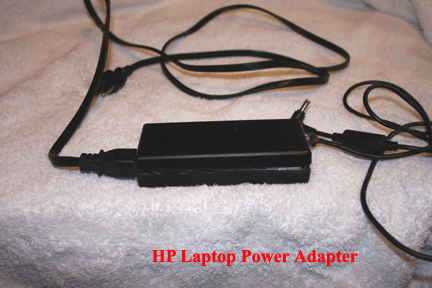
Shared Knowledge
"HP Laptop Power Adapter - Inside"
22 February 2009
Summary: for your information (FYI), just a look inside a laptop power adapter.
You knew it all along. If a laptop power adapter is defective, it is simply a throw away. But I hate adding to the landfill and so if I think I can repair, I try.
Inherited HP laptop. Would not power on. Check of laptop end of power adapter showed no voltage. Noticed cord from adapter to laptop had a nasty bulge in it right where cord came out of adapter. Cut there, made a clean connection and laptop fired up. Coated my new connection with liquid electrical tape and could have left it that way, but laptop headed to daughter that is rough on everything, so thought best I try to get inside adapter, cut out bad section of cord and solder clean to circuit board.
So what you see below is my efforts to get inside and repair an HP laptop power adapter. Although I say HP, I am sure most laptop adapters are equally hard to get and appear very much the same, once you are in.
Oh, a big note here. The circuit board in the HP laptop power adapter is marked "Lite-on". If you check eBay you will see a lot of "Lite-on" laptop power adapters being sold as direct replacement for a manufacture's adapter and in the case of HP, this is absolutely true, or was.
Sometime in the past, I have put a flat blade screwdriver into the groove that runs entirely around a laptop power adapter and tried to separate the top and bottom plastic cover. Suspected that plastic covers where simply snapped into place, but no matter how much I tried to pop the pieces apart, all I did was damage the plastic case.
This time, I decided I would use a Dremel tool to cut along the groove and again see if I could separate the 2 halves of the plastic case. (Sometimes, on some repair jobs, only a Dremel tool will work.)
So I began with the Dremel tool along side, going slow as I had no idea how close the actual supply components may be to the plastic case and did not want to damage any. Cut completely along one side and tried flat blade screw drive. Plastic cases would not budge. Cut along other side of case. Again, cases would not separate. Took Dremel and began to cut deeper and hit metal. Back off and look. Metal looks like a metal case or shield. Cut some more along one side and expose metal all along the side groove. Take Dremel tool to other side and cut down to exposed metal. Again the screw driver to get plastic cases off (still thinking that they snapped together somehow or perhaps were glued to metal that appeared to be wrapping the inside of the adapter. Still could not get plastic covers off. Took Dremel to ends of adapter and on one end, no problem but on other hit a different kind of metal. Backed off. This time, when I used the flat blade screw driver, plastic top and bottom separated.
In the end, just not sure how plastic wrapped around power adapter. Could not see how one piece snapped or glued into the other. Mystery.
Again, all I wanted to do was to cut out a bad section of adapter-to-laptop cable and solder a good connection to the circuit board and having removed the plastic cover this would have been as far as I needed to go in disassemble. However, upon examination, when cutting the plastic along one end of the adapter, I had accidentally cut into the circuit board component known as a "choke". Now as only a wire cut, you would think I could splice in a small piece of wire and solder at both ends but all my attempts in the past have not been successful as the current flowing through the choke simply "burns" through the soldered connections. And even if I was successful in repairing the choke, I could not trust it forever and why would I risk it when replacement adapters are so cheap and readily available?
So in the end, the laptop power adapter I attempted to repair is going to the landfill and I have now order a $30 replacement off eBay, which I should have done in the first place.
Well, no since stopping now as perhaps someone, somewhere, might be able to go on inside for actual adapter component replacement. So below is a picture of the adapter with the metal skin removed. Too bad that Lite-on did not completely wrap the adapter in metal and then I would not have damaged the choke but the adapter is clearly not made to be ever repaired.